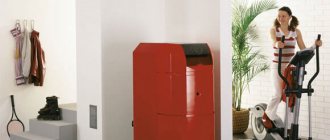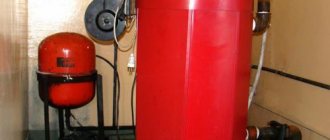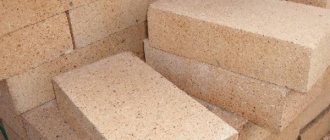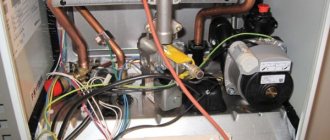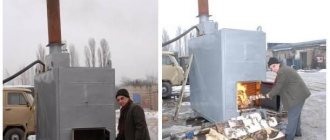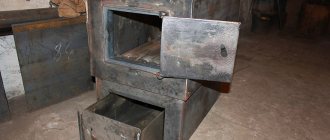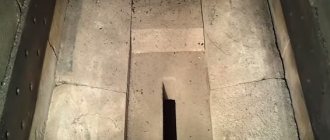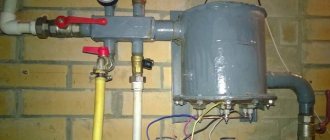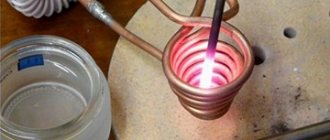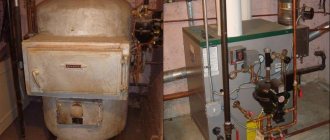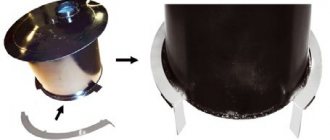Device
The boiler is a metal body, which has two chambers - loading and combustion. To protect against high temperatures, the walls of these chambers are lined with fireclay bricks or other suitable heat-resistant material, for example, concrete-based.
Using fireclay bricks, lay out the bottom of the loading chamber, leaving a small gap - a nozzle through which pyrolysis gas will flow into the combustion chamber. Tubular structures are usually used as a heat exchanger.
Advantages and disadvantages of pyrolysis boilers
Now you know what the operating principle of a pyrolysis boiler is. In fact, this is a gas generating unit that produces a large amount of thermal energy. If we compare the calorific value of wood in direct combustion and in pyrolysis, then in the second case it is 10-15% higher. This reduces fuel costs. Let's look at the main advantages of pyrolysis furnaces arising from their operating principle:
Depending on the design features, the afterburner can be located either under or above the fuel loading furnace. In terms of performance, both options are almost equivalent.
- Economical – the ability to save fuel is very important, because a full truck of firewood is quite expensive;
- Increased heat release - the operating principle of pyrolysis boilers allows you to extract more energy from a kilogram of logs than during their direct combustion;
- Long-term work from one stack of firewood will allow you to calmly do your homework, and not sit at the pyrolysis boiler to put another portion of logs into its insatiable firebox;
- Environmental friendliness - thanks to combustion at maximum temperature, the amount of harmful emissions into the atmosphere is reduced;
- The ability to adjust the combustion intensity within fairly large limits - provides more accurate temperature control;
- Ease of maintenance - pyrolysis boilers are equipped with doors for access to the combustion and afterburning chambers, as well as for access to the ash pan;
- Increased efficiency - for some models it is up to 90%. This indicator is typical only for gas units, and even then not for all;
- The ability to heat large buildings - for this purpose, high-power pyrolysis boilers are produced. In terms of their operating principle, they are not much different from their low-power counterparts.
Unfortunately, there are some drawbacks:
- Impressive dimensions - even the lowest-power pyrolysis boilers are distinguished by their dimensions. They have large heat exchangers and two combustion chambers + an ash pan. In addition, equipment often contains water jackets that serve to cool them - their thickness is up to several centimeters;
- Increased requirements for firewood - when using raw firewood, the generation of pyrolysis products can be difficult. Therefore, logs for pyrolysis boilers must be stored in a dry place, otherwise the operation of the equipment will be characterized by low stability - water vapor will interfere with the normal course of the pyrolysis reaction;
- High cost - even if you assemble it yourself, the costs will be high, because this will require good sheet metal. The cost of factory samples ranges from 50-60 thousand rubles and more, depending on the power;
- Some models require connection to an electrical network - their operating principle is to use an electronic control module that controls the operation of the blower fan. To heat buildings without electrification, mechanically controlled pyrolysis boilers are used - they still have the same operating principle.
Most of all, consumers are confused by the high cost of equipment. But if you want to experience savings on fuel and ensure good temperature control when working with wood, you should purchase a pyrolysis boiler.
Principle of operation
A certain amount of firewood, which is determined by the volume of the loading chamber, is loaded into it and pre-ignited when primary air is supplied. When the fuel ignites, conditions are artificially created with insufficient oxygen content, due to which flammable gas is released from the wood. It is a mixture of carbon monoxide and volatile hydrocarbons. As the pressure in the loading chamber increases, it flows through the nozzle into the combustion chamber. Secondary air is also supplied here. Its mixing with pyrolysis gas, as well as high-temperature conditions, ensure ignition and combustion of the gas mixture.
During combustion, heat, carbon dioxide and water are released - in most cases, they speak of complete combustion of the fuel with the release of “clean” combustion products listed above. Heat through the walls of the heat exchanger is transferred to the coolant, which is water circulating in the water heating system. Cooled combustion products are discharged through the chimney.
How do pyrolysis boilers work?
The operating principle of a pyrolysis boiler is to generate combustible gases and then burn them. In order to understand how it works, we should recall an interesting experience from a school physics textbook. There it was proposed to enclose some wood chips in a glass flask, plugged with a stopper with a thin tube. The flask was placed under the burner, after some time the pyrolysis reaction began in it. After this, flammable gases began to emerge from the tube, which were easily ignited and burned with a bright flame.
The operating principle of a pyrolysis boiler is based on a similar reaction, only on a larger scale. There are two cameras involved here:
- Combustion chamber - the fuel is pre-ignited in it, after which the firewood is in a slow smoldering mode, with limited air access;
- Afterburner chamber - pyrolysis products burn here, generating heat that is sent to the fire tube heat exchanger.
This entire facility is cooled by a water jacket.
Studying the principle of operation of a pyrolysis boiler, it may seem to you that the effectiveness of this technique is extremely low. In fact, a lot of gases are released. If we look into the afterburning chamber, we will see a powerful roaring flame there, releasing a wild amount of thermal energy.
Combustion chambers in pyrolysis boilers can be located in any sequence. For example, one above the other or sequentially, one after another. There are also units in which afterburning is carried out under the main firebox. The combustion intensity is adjusted using a blower fan or using the blower door . It should be noted that the adjustment range is quite large - if necessary, the flame can be extinguished almost completely.
The operating principle of the pyrolysis boiler involves preliminary ignition of wood fuel. We need the wood to be well ignited. To do this, the throttle valve and the blower are opened, and a portion of firewood with small splinters for ignition is placed in the firebox. We set it on fire and wait for a stable fire to appear. Now our pyrolysis boiler is ready for full launch. We perform the following actions:
Thanks to the design of the pyrolysis boiler, hot air does not fly out into the chimney immediately, but first passes through a special compartment. This allows the system to significantly increase its efficiency compared to conventional boilers.
- Close the throttle valve;
- Close the blower door;
- Turn on automation;
- We observe the temperature increase in the system.
Let's take a look at how a pyrolysis boiler works inside - there's a lot of interesting stuff going on here. Firstly, after cutting off the supply of oxygen, our cheerful flame turns into smoldering embers. And secondly, after the automation is started, the blower fan turns on, the pyrolysis products are sent to the afterburning chamber, where a powerful flame begins to rage. This operating principle is implemented in all pyrolysis boilers. The only differences are in the adjustment scheme - in some places electronics are responsible for automatic adjustment, and in others simple mechanics.
Advantages and disadvantages
The advantages and disadvantages of such equipment, summarized here in one table, will allow you to more objectively approach the assessment of a possible purchase.
Pros and cons of pyrolysis boilers
| Behind | Against |
| These are so-called long-burning boilers: you can load a batch of firewood that will burn for a very long time, about 12 hours (on coal under certain conditions, even longer) | But you will have to pay for it in blood. These boilers are definitely more expensive than traditional solid fuel boilers. Sometimes the price difference is 50–100% |
| The fuel burns almost completely, which means that we use most of its energy potential. In addition, this minimizes the amount of waste and eliminates the need for frequent boiler cleaning | A forced air injection system is used, which means that the boiler is volatile, that is, potential power outages turn into a big problem |
| Large wood can be used as fuel. In most cases, you can limit yourself to adding unsplit fuel. | The efficiency of the boiler largely depends on the moisture content of the wood. The usual requirement is that humidity should not exceed 25% |
The video below provides another opinion. It should not be considered as the ultimate truth, but you definitely need to think about certain issues.
And here is another video from the same ardent opponent of pyrolysis boilers. Some arguments sound quite convincing, but many need to be taken critically.
As you can see, the operation of such equipment may have some nuances. In any case, before purchasing a boiler, it is advisable to additionally familiarize yourself with the various offers of manufacturers, since there are many of them today.
Drawings of pyrolysis boilers (PDF), structure and principle of operation
What is a pyrolysis boiler? Its structure How it works Pros and cons Assortment of factory boilers Reviews of do-it-yourself manufacturing
Go to download drawings
Firewood has been and remains the most accessible and inexpensive type of fuel for heating a private home.
But the advantages of using this type of fuel do not eliminate its significant drawback - traditional solid fuel boilers need to be constantly fed with new and new portions of firewood.
Being constantly tied to the firebox is not a very pleasant experience! A solution was found with the development of long-burning pyrolysis boilers.
What it is?
Pyrolysis boilers belong to the solid fuel family; The difference from traditional boilers is that combustible components are first removed from the fuel. The combustion process is carried out in two stages: gas extraction under conditions of high temperature and low oxygen content and combustion of a mixture of heated gases and air.
Prices for drawings of higher power boilers
- 30 kW – 5,000 rub.
- 100 kW – 50,000 rub.
- 300 kW – 75,000 rub.
- 500 kW – 100,000 rub.
(1 5,00 of 5) Loading...
Range
The products are widely represented, since the extraction of pyrolysis gas has been known for quite a long time and the technology has been tested in the chemical industry.
As a rule, most large manufacturers of boiler equipment also have a line of long-burning boilers. In the table below we have indicated the most popular heating equipment from Russian, Ukrainian and German manufacturers. Before considering a specific model, it is strongly recommended to calculate the boiler power using our small online calculator. Popular models of pyrolysis boilers for private homes
| Boiler name | Short description | Model | Power / approximate heated area, kW/m2 | Approximate price, rub. |
| Atom, Motor Sich | Ukrainian, for firewood with dimensions (380–1000)×(100–410) mm and humidity up to 50%. Walls made of steel 6–10 mm, protected with ceramic concrete | MS-16 | 8–19/80–190 | 120 000 |
| MS-25 | 13–30/130–300 | 138 000 | ||
| MS-32 | 16–38/160–380 | 162 000 | ||
| Teplogarant, Burzhuy K | Russian single-circuit boilers are low cost | Standard T-10 | 10/100 | 40 000 |
| Standard T-20 | 20/200 | 56 000 | ||
| Standard T-30 | 30/300 | 69 000 | ||
| Atmos | Czech equipment made of steel 3–8 mm thick, individual elements of which are protected by ceramic blocks | DC 15E | 10–15/100–150 | 72 000 |
| DC 18S | 14–20/140–200 | 81 000 | ||
| DC 22S | 15–22/150–220 | 94 000 | ||
| DC 25S | 17–25/170–250 | 96 000 | ||
| Vulcan | Ukrainian single-circuit steel 5 mm thick. The nozzle and ash pan are made of high-strength heat-resistant concrete | ECO 15 | 15/80–100 | 81 000 |
| ECO 20 | 20/150–200 | 85 000 | ||
| ECO 25 | 25/200–250 | 87 000 | ||
| ECO 30 | 30/250–300 | 91 000 | ||
| Miracle | Russian pyrolysis boilers can be equipped with an electric heating element, automatic or manual draft regulator | 10 | 8–12/100 | With a manual draft regulator: with a heating element – 55,000, without a heating element – 49,000. With an automatic draft regulator: with a heating element – 66,000, without a heating element – 59,000 |
| 18 | 12–18/185 | With a manual draft regulator: with a heating element – 65,000, without a heating element – 59,000. With an automatic draft regulator: with a heating element – 76,000, without a heating element – 69,000 | ||
| 30 | 18–30/300 | With a manual draft regulator: with a heating element – 82,000, without a heating element – 75,000. With an automatic draft regulator: with a heating element – 91,000, without a heating element – 84,000 | ||
| Trajan (some write Trojan) | Russian long-burning boilers with the ability to connect an electric heating element | T10 | 10/90 | 47 000 |
| T15 | 15/120 | 51 000 | ||
| T20 | 20/120–220 | 56 000 | ||
| T30 | 30/240–330 | 70 000 | ||
| Buderus (Buderus) | German single-circuit boilers | Logano S121-2 21 | 21/210 | 163 000 |
| Logano S121-2 26 | 26/260 | 166 000 | ||
| gano S121-2 32 | 32/320 | 177 000 | ||
| Viessmann | Another award-winning German manufacturer of boilers made of steel with a thickness of at least 8 mm | Vitoligno 100-S VL1A024 | 25/250 | 170 000 |
| Vitoligno 100-S VL1A025 | 30/300 | 220 000 | ||
| Geyser | Russian single-circuit (PK) or double-circuit (PK2) long-burning boilers | PK-10 (PK2-10) | 10/100 | 48 000 (51 000) |
| PK-15 (PK2-15) | 15/150 | 53 000 (56 000) | ||
| PK-20 (PK2-20) | 20/200 | 59 000 (61 000) | ||
| PK-30 (PK2-30) | 30/300 | 72 000 (76 000) | ||
| BTS | Ukrainian boilers made of steel with a thickness of 5 mm (standard class) and 6 mm (premium class). Ceramic lining | BTS-15 | 15/180 | 117 000 |
| BTS-20 | 20/230 | 121 000 | ||
| BTS-25 | 25/280 | 139 000 |
We invite you to watch a short video about the operation of Trajan boilers.
A little visualization of the work of Buderus pyrolysis boilers is in the video below.
And also about the rather popular boilers from TeploGarant - Bourgeois K.
Yes, by the way, there are models that are designed to work with different fuels. This can be coal, peat and even pellets. The use of pellet boilers allows you to largely automate the fuel supply process.
Reviews
Among the sea of custom reviews, it is very difficult to find opinions that are truly unbiased and based on real impressions. What users usually complain about:
- excessive formation of tar due to the fact that the required high temperature is not maintained in the combustion chamber;
- the need to install an additional buffer tank with water, which will accumulate excess heat;
- small steel thickness, which leads to changes in the geometry of the body and burnout of its individual parts.
What to pay attention to when making
If you are going to make a pyrolysis boiler with your own hands, you need to clearly understand not only the mechanism and principle of its operation, but also take into account all the unpleasant aspects that these units have. First of all, it must be said that almost all pyrolysis gases are poisonous. That is, the unit must be completely sealed, the welds must be of the highest quality.
In addition, to ensure safety, a combustion process monitoring system (temperature, smoke, draft presence sensors) and automation are required, which, depending on sensor readings, regulates combustion processes. If you are going to make a homemade pyrolysis boiler using natural draft, the automation can be as simple as possible - non-volatile. If there is a boost fan to supply air into the current, more serious (and expensive) devices are needed, and they are powered from a 220 V network. Operating a boiler of this type without automation is dangerous, therefore an uninterruptible power supply is needed that will ensure the operation of the fan and automation at 10 -12 hours is the burning time of the bookmark.
Approximate layout of a pyrolysis boiler
Second point. In some models of pyrolysis machines, the temperature in the active phase reaches 1000°C and higher. Ordinary structural steel will quickly burn out under such conditions. In order for the boiler to last for a long time, heat-resistant steel and internal lining of the most thermally loaded parts are necessary. If you make a pyrolysis boiler yourself, the lining is most often made of fireclay bricks. In the working phase, the fireclay heats up to a crimson glow and becomes very fragile. If, suddenly, you have to work in the furnace at this time, be careful - it is easy to damage the lining at the moment, but repairing it will be long and difficult.
With your own hands
Below is a 25-minute video of designing and making your own pyrolysis boiler. The author describes the assembly process step by step and also talks about the difficulties encountered.
Possible mistakes:
- Wrong alloy. The most common mistake, which, by the way, is typical not only for home-made models, is the use of the cheapest materials from ferrous metals. They do not belong to the category of heat-resistant materials, which ultimately leads to burnout of the structure and difficult, or even simply impossible, repairs. It is necessary to carefully select the steel grade and use special heat-resistant alloys. For example, 20Х23Н18 and the like.
- Small thickness of steel. Another mistake is the incorrectly selected thickness of the steel sheet. This parameter is determined based on the temperature distribution throughout the boiler, but the minimum value is about 5 mm. The thicker it is, the more expensive it is, but then the boiler will work longer.
Blueprints
An attraction of unheard of generosity – there’s no other way to describe it! From us you can download drawings of pyrolysis boilers completely free of charge. This will allow you to assemble the heart of the heating system in your backyard or garage if you wish.
We present long-burning boilers, which you can find under the Bourgeois K brand. Drawings of a 20 kW boiler can be downloaded for free from the link below.
- .
- ;
See examples of graphic materials in the images below.
You also have a unique opportunity to order a set of drawings for one of the models at a very attractive price. Of course, this is an option for those who are going to make a boiler with their own hands, not only for themselves, but also to order. To contact, use the form below.
Assembling a two-chamber firebox
It is better to choose a hot-rolled sheet with a thickness of at least 8 mm, ideally 10–12 mm, as the material for making the chamber walls. The thicker the metal, the more difficult the welding process, but a structure made of too thin steel is guaranteed to move and twist in unpredictable directions. That is why among the parts from which the boiler is assembled there should not be small elements with an aspect ratio of more than 2:1.
The basis of a two-chamber firebox is the outer side walls. They are common to both chambers and are connected through the front wall, in which two rectangular holes are made for the doors. The lower hole is intended for servicing the combustion chamber, its height should be about 120–150 mm, width - at least 300 mm, the hole is located at a distance of 150 mm from the bottom edge. The upper hole is intended for loading the gasification chamber; the larger it is, the better; the hole should be located no closer than 100 mm to the top of the chamber. From below and at the back, the firebox is closed with solid sheets, which are cut to fit the external dimensions of the combustion chamber, but are not welded until the internal parts are assembled. The top of the boiler is covered with a sheet of nominal cross-section.
Example of dimensions of a pyrolysis boiler
The gasification and combustion chambers will be separated by a solid plate, the width of which corresponds to the internal distance between the walls, and the length is 400 mm less. At the back of the plate, a solid partition is welded vertically, which separates the loading chamber along its entire height; a hole 50 mm wide and 400–600 mm long is cut in the center along the horizontal part. The assembled L-shaped partition is not welded until the heat exchanger assembly is completed.
